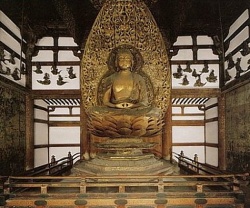Difference between revisions of "Kalpa of formation"
m (1 revision: Robo 2.48 15 septmeber replacetext) |
|||
| Line 1: | Line 1: | ||
[[File:Jocho rama-TN.jpg|thumb|250px|]] | [[File:Jocho rama-TN.jpg|thumb|250px|]] | ||
| − | + | [[kalpa of formation]]<br/> | |
| − | [[kalpa of formation]] | ||
[[成劫]] (Jpn [[jo-ko]] ) | [[成劫]] (Jpn [[jo-ko]] ) | ||
| − | + | One of the four [[kalpas]]. The period of the first stage in the cycle of {{Wiki|formation}}, {{Wiki|continuance}}, {{Wiki|decline}}, and {{Wiki|disintegration}} that a [[world]] is said to undergo repeatedly. In this [[kalpa]], a [[world]] takes [[shape]] and living {{Wiki|beings}} appear in it. According to The [[Dharma Analysis Treasury]], the [[power]] of the [[karma]] of living {{Wiki|beings}} first [[causes]] a small [[wind]] to arise in {{Wiki|space}}. This [[wind]] grows and [[forms]] the windy circle [[thought]] to lie at the base of a [[world]]. Upon this windy circle, a watery circle and then a {{Wiki|gold}} circle take [[shape]], and upon them [[forms]] the land, with a [[Mount Sumeru]], seas, and mountains. Then living {{Wiki|beings}} begin to appear, first in the [[heavens]], then in the [[human]] [[world]], and [[successively]] in the lower of the six [[worlds]], until finally {{Wiki|beings}} appear in the [[hell]] of incessant [[suffering]]. This [[kalpa]], like the other three [[kalpas]] of the cycle, lasts for twenty small [[kalpas]]. Each small [[kalpa]] is said to last nearly sixteen million years. | |
See also [[kalpa]] | See also [[kalpa]] | ||
| − | + | ||
| − | {{ | + | {{R}} |
| − | [http://www.sgilibrary.org/search_dict.php?id=1150 | + | [http://www.sgilibrary.org/search_dict.php?id=1150 sgilibrary.org] |
| + | |||
[[Category:Kalpa's]] | [[Category:Kalpa's]] | ||
Latest revision as of 19:10, 29 March 2014
kalpa of formation
成劫 (Jpn jo-ko )
One of the four kalpas. The period of the first stage in the cycle of formation, continuance, decline, and disintegration that a world is said to undergo repeatedly. In this kalpa, a world takes shape and living beings appear in it. According to The Dharma Analysis Treasury, the power of the karma of living beings first causes a small wind to arise in space. This wind grows and forms the windy circle thought to lie at the base of a world. Upon this windy circle, a watery circle and then a gold circle take shape, and upon them forms the land, with a Mount Sumeru, seas, and mountains. Then living beings begin to appear, first in the heavens, then in the human world, and successively in the lower of the six worlds, until finally beings appear in the hell of incessant suffering. This kalpa, like the other three kalpas of the cycle, lasts for twenty small kalpas. Each small kalpa is said to last nearly sixteen million years.
See also kalpa
